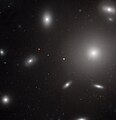Soubor:NGC 4874 HST.jpg

Velikost tohoto náhledu: 578 × 600 pixelů. Jiná rozlišení: 231 × 240 pixelů | 463 × 480 pixelů | 740 × 768 pixelů | 987 × 1 024 pixelů | 1 973 × 2 048 pixelů | 3 864 × 4 010 pixelů.
Původní soubor (3 864 × 4 010 pixelů, velikost souboru: 5,95 MB, MIME typ: image/jpeg)
Historie souboru
Kliknutím na datum a čas se zobrazí tehdejší verze souboru.
| Datum a čas | Náhled | Rozměry | Uživatel | Komentář | |
|---|---|---|---|---|---|
| současná | 20. 9. 2011, 13:55 |  | 3 864 × 4 010 (5,95 MB) | Jmencisom |
Využití souboru
Tento soubor používá následující stránka:
Globální využití souboru
Tento soubor využívají následující wiki:
- Využití na ar.wikipedia.org
- Využití na arz.wikipedia.org
- Využití na ast.wikipedia.org
- Využití na az.wikipedia.org
- Využití na be.wikipedia.org
- Využití na ce.wikipedia.org
- Využití na de.wikipedia.org
- Využití na diq.wikipedia.org
- Využití na en.wikipedia.org
- Využití na et.wikipedia.org
- Využití na eu.wikipedia.org
- Využití na fr.wikipedia.org
- Využití na hr.wikipedia.org
- Využití na it.wikipedia.org
- Využití na ja.wikipedia.org
- Využití na kk.wikipedia.org
- Využití na ko.wikipedia.org
- Využití na mk.wikipedia.org
- Využití na nl.wikipedia.org
- Využití na pl.wikipedia.org
- Využití na ru.wikipedia.org
- Využití na sk.wikipedia.org
- Využití na sl.wikipedia.org
- Využití na tt.wikipedia.org
- Využití na uk.wikipedia.org
- Využití na uz.wikipedia.org
- Využití na www.wikidata.org
- Využití na zh.wikipedia.org